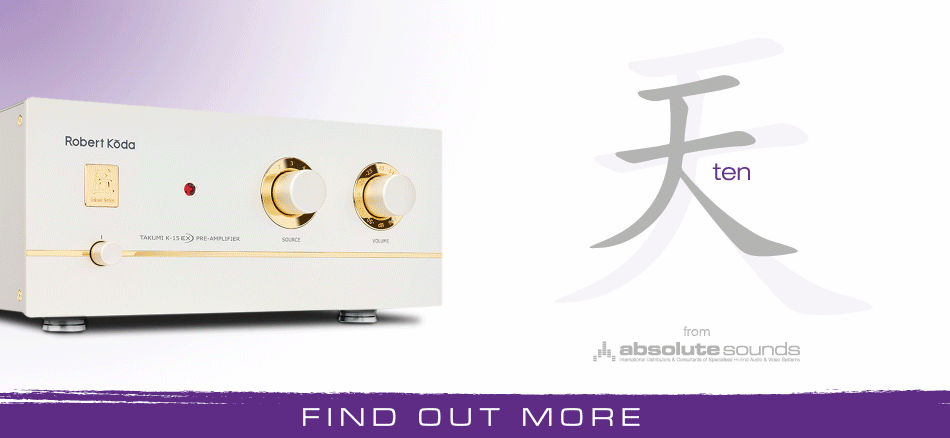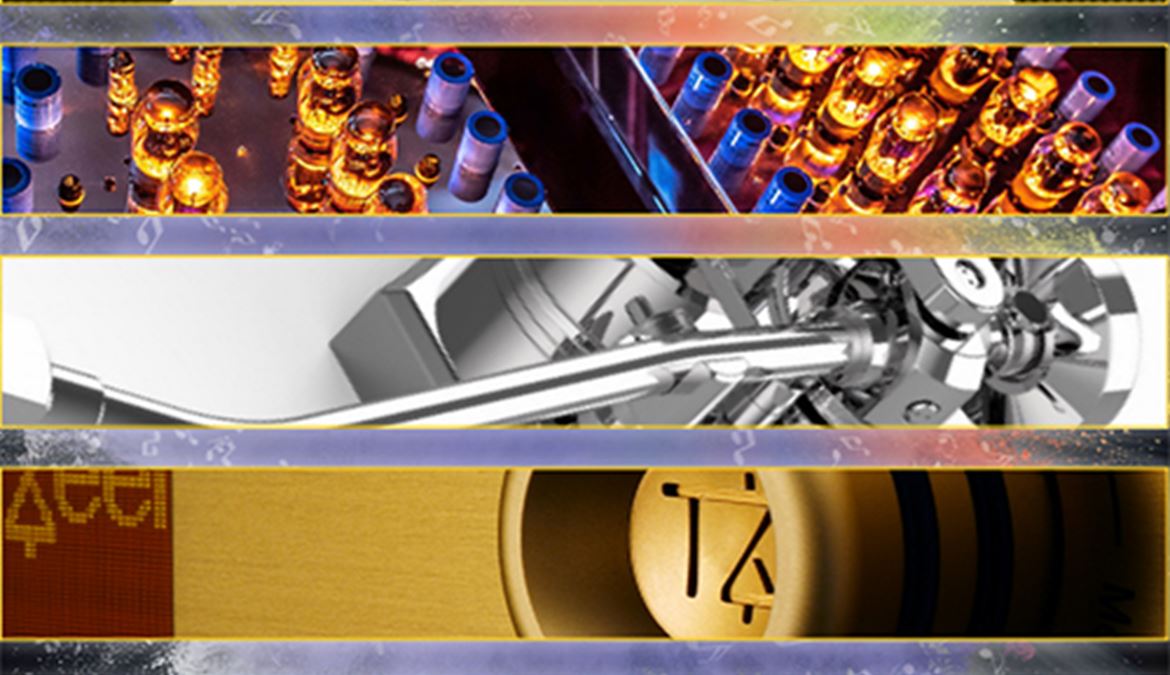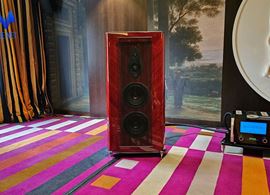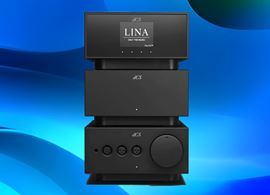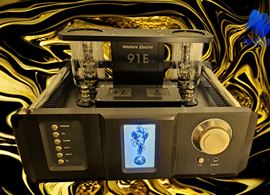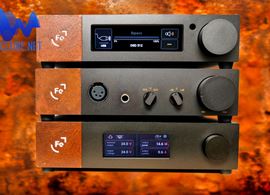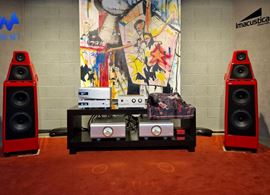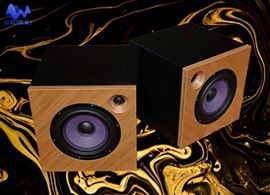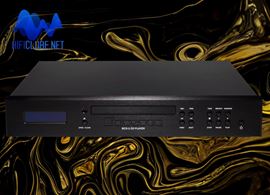Ricardo Franassovici perguntou a um grupo de conhecidos críticos de áudio qual a diferença entre um sistema caro e um sistema equilibrado e montado por profissionais. Eis as respostas. Note: all texts in English.
Não temos por hábito publicar na integra as newsletters dos nossos patrocinadores, mas a mais recente newsletter da Absolute Sounds vai muito para além da mera promoção das marcas e produtos que distribui.
O dinheiro é tudo no áudio?
Ricardo Franassovici não só escreveu um texto sobre o que considera ser um bom som, como desafiou algumas personalidades do áudio para dissertarem sobre a diferença entre o que se pode esperar de um sistema caro (e com boas medidas) e um sistema equilibrado com todos os 'instrumentos' que o compõem bem afinados e sintonizados.
Exclusivo Absolute Sounds/Hificlube.net
Hificlube conseguiu o exclusivo, não apenas porque JVH foi amavelmente incluído na lista dos convidados, mas porque alguns dos textos são de grande qualidade e merecem divulgação. Eis todos os textos por ordem de publicação na Newsletter.
Os críticos convidados
Michael Fremer, Editor de Analog Planet e colaborador da Stereophile
José Victor Henriques, Editor Hificlube.net
Matej Isak, Editor da Mono&Stereo
Ken Kessler, Autor e colaborador da Hi-Fi News
Alan Sircom, Editor HiFi+
Rafael Todes, Músico e crítico freelance

Ricardo Franassovici, Absolute Sounds
Dear Music Lover,
When I left the rock music industry in the late 1970s, I had a dream of what good audio could produce. I believed that we could make sounds that reproduces the euphoria you get sitting in the studio or listening to the live event. This wasn’t for the audiophiles – those people who, to paraphrase Sir Thomas Beecham, “may not like music but they absolutely love the noise it makes” – but something that can captivate any music lover.
That musical goal was never referenced against other audio devices, but was instead shaped by two important factors: How does sound of a component reference to the sensation of listening to the live event, and how does that product integrate with other components?
These two vital elements remain at the core of Absolute Sounds. Our products are never benchmarked against audiophile devices, but by how close they get to reproducing the studio or the concert hall. Also, while instinctually speaking if products get close to achieving that goal, they should all work together well, that isn’t always the case. We strive to make sure our finest instruments of music reproduction are the ones that ‘play nice’ with other components.
The art of achieving both is extremely complex and takes a lot of listening and a great deal of gained experience to deliver anything close to a decent result. We at Absolute Sounds believe that – with our more than 40 years within the industry and more than a decade before that in the music biz – we have honed and refined that art and will continue to do so.
Sadly, it’s so easy to get this process wrong, and the results are often a near miss that undermines everything that music is supposed to do. While many obsess about eliminating noise or removing resonance, I feel the goal is reducing what I call ‘electronicity’ – the feeling as if the music is being treated as just another ‘signal’, ending up over-processed and far removed from the original intent and passion of the musicians who recorded that work. Simply put, ‘electronicity’ takes away from the music itself, leaving something – to quote Shakespeare – “full of sound and fury, signifying nothing.”
It’s no accident that our product lines frequently take an elegant and minimalist design, often because adding additional stages and steps between musician and listener undermine that musical intent, focusing instead on the ‘signal’. We always try to do more than simply build good audio systems, instead creating a lifestyle that supports the beautiful interaction of a music collection – however you build that collection – allowing the music lover to curate their collection and replicating in the home everything about the studio or the concert hall.
We think a well matched, beautifully constructed system of musical reproduction instruments in a listening room is as much of an important indulgence as a good wine cellar, a well-stocked cigar humidor, or a garage full of classic cars. It’s something to savour and enjoy that engages all the senses, not just one – which is why we think it’s something you feel and experience as much as you ‘hear’.
The joy of a top-notch audio system is that it transforms your music room. It’s like Dr Who’s TARDIS without the plummeting ratings; translocating you to moment in the studio or the concert hall where that recording took place. It’s also good for you: listening to music that you love so much it ‘gives you the chills’ has been shown to trigger a release of two neurotransmitters: dopamine and serotonin. Dopamine is a neurotransmitter associated with feeling happy (it’s known as ‘the feel good’ chemical central to our reward system), while serotonin is linked to relaxation states (it regulates sleep). The right recordings played well improves our well-being by heightening our enjoyment and make us more relaxed.
But profound musical satisfaction in the home would be impossible to achieve were it not for many like-minded people who also understand this musical concept, be they manufacturers and suppliers, our partners in retail, our passionate clientele, and refined and distinguished music lovers in all walks of life.
In our time-poor, stressed-out world, the need to just take some time to sit back and relax has become more important than ever, and few things (Or at least, few things that are legal and good for you) help this so well as good music, played perfectly. And to make that good music sound even better… that’s what makes me get up every morning!
Lastly, to add to your pleasure for the few that feel they have seen and heard it all, feel free to join Ten at ten-collection.com.
Musically yours, Ricardo Franassovici, Absolute Sound
MICHAEL FREMER Editor - AnalogPlanet, Senior Contributing Editor - Stereophile
Assembling a sound producing audio system is easy. Putting one together that creates a sublime musical performance is difficult though doable.
“Throwing money” doesn’t guarantee a great result. Within reasonable bass, dynamics, and spatial scale expectations, a moderately priced, carefully selected system can be as musically transportive as a massive, costly one that effectively creates the illusion of putting you in a good seat at a great hall—and if you don’t think an audio system can do that it’s only because you’ve not experienced it.
The oft-made food analogy works up to a point: even the finest ingredients do not guarantee a memorable meal. Preparation and proportions matter equally. If the finest, most costly ingredients call attention to themselves at the expense of the gastronomic creation, the meal is a failure. When it all works together, well hopefully we’ve all experienced at least a few such unforgettable meals— sometimes, surprisingly and unexpectedly in real “dives”.
Not so with audio. Even a carefully selected, costly system capable of producing at the push of a few buttons the most sublime musical experience can fail miserably if it’s placed in the wrong room, or in the wrong place in the room, or in one that’s not been acoustically prepared, or the electrical service is problematic. Or if the cables are lazily chosen.
Sounds discouraging, but good results are more easily attained and that’s what most systems achieve for most audio enthusiasts just as you can grab a decent meal at your local bistro.
Systems that when playing the most subtle music—not the usual sonic “potboiler” demo discs— raise arm hair, produce goose bumps, put mouths agape, force fingers to involuntarily point at non-existent musicians appearing in the room and get wives to exclaim almost against their will “You have to buy this!” are most often the ones where all of the above has been taken into account and experienced hands are at the wheel.
JOSÉ VICTOR HENRIQUES Editor - hificlube.net
I once quoted a Louis Armstrong song to describe a particularly good characteristic of an amplifier: ‘it don’t mean a thing, if it ain’t got that swing’.
Swing is not just about rhythm. Nor is it just about time and pace. It’s a feeling. You either have it, or you don’t. It’s genetic, maybe. Anyway, it’s a human ‘thing’. Thus amplifiers and speakers don’t have it. But some can trigger it on you.
Most don’t. A measuring device will look at voltage input swing and miss the whole point.
Recently I went as far as relying on Phonetics to try to understand why some audio components let you hear the whole of a syllable: onset, rhyme, nucleus and coda, and get all the phonemes right while others don’t.
Like Sinatra, who never missed a syllable, and Jacques Brel who ‘hammers’ each and every one of them in ‘JoJo’, like nails in a coffin, to convey pathos and the grief he feels for his friend’s death. Some amplifiers and speakers ‘nail’ it (if you catch my drift). Most don’t.
As precise as it may be, an Audio Precision cannot understand pathos and matters of life and death, and why we laugh and cry and dance and sing along while listening to music with some systems and others leave us cold and indifferent.
An electrocardiogram is a valuable tool to evaluate if one’s heart is healthy and pumping well. But it will never tell you how good-hearted someone is. And yet, we instinctively know by just listening to it…
MATEJ ISAK Editor - mono&stereo
With all the enticing audio equipment, audiophiles and music lovers are drawn into the enticing world of high-end audio. Even more, than in other industries, careful selection is required here to achieve the greatest possible goal, and here comes the real question.
What makes the difference between a bling-bling, swanky high-end audio system and a very well put together, refined, balanced high-end audio system?
The experience of a system builder, a provider, a curator who is able to understand the true essence of the music being conveyed without losing anything in the translation. A quality audio system is far more than the sum of its expensive parts. A careless assemblage of expensive components has a hard time getting to the core of the music and causes restraint.
In contrast, a savvy high-end system works in the spirit of the music, bypassing the logical circuits and cementing the emotional journey to musical heaven. No matter how impressive an ultra-high-end audio system may seem, if it is not assembled and finely tuned, the whole being will react with resistance rather than emotional empowerment. Fatigue that acts as stress. As humans, we are wired for fatigue, and the human body and brain reject something unpleasant by preventing the formation of a pleasant cocktail of the right chemicals to ignite.
However, when everything comes together, a high-end audio system should reproduce the true sound and merge the concretely formulated essence that goes beyond the undertone of causality. It calms and stimulates the internal clock, allowing the original rhythmic dynamics and a basic framework with universal appeal and sheer joy.
The properly assembled system not only provides an attention-grabbing, formative focus. It goes beyond the ordinary and transcends time and space. A careless mix of components merely outlines reality and never goes beyond a pale backdrop that hints at the actual and invalidates the music. The real system should be opening a portal to the infinite musical universe, where each re-listening is rewarding, elevating the spirit and permitting intimate, exquisite acquaintance with the performers.
A calibrated high-end audio system shimmers vivid sound poetry and creates a picturesque sound canvas onto which the music is projected vividly and soulfully. The magic of music lets the listener travel to the remote wonderlands evoking immense pleasure and enchantment. An intense, higher feeling with a genuine musical message transmitted unabridged.
The real well-balanced should shimmer should touch the soul and shimmer a cultural s.

KEN KESSLER Author, Contributor - HiFiNews
What is the difference between a merely great system, and one which yields the ultimate realism? Drive the brilliant Porsche Cayman, then the 911. Use a Leica Q, and then try an M10. Drink a glass of Le Serre Nuove, followed by Ornellaia. It is all about that extra stage of refinement, of attainment, and – ultimately for hi-fi – of communication. With each of those examples, only one’s proficiency as, respectively, a driver, a photographer and a wine connoisseur will allow the comprehension of those gains. For high-end audio, then, the onus is on one’s listening skills.
It may be the delivery of deeper, more authentic bass, perhaps the recreation of a wider soundstage, or the provision of the revelation afforded by greater transparency. It is why manufacturers create hierarchies which carefully elevate the performance a stage at a time. They ensure that each model’s sonic capabilities are reflected in the price or the size, but categorically, it corresponds to the position in the family tree.
To illustrate the ascent one undertakes when moving from an excellent system to a life-changing assemblage of state-of-the-art components, look at the way respected manufacturers of undeniable provenance configure their catalogues. They strive to make each model yield specific, identifiable gains over the entry below, be they amplifiers, speakers, turntables or cables. When one reaches that final stage, the sound should be above reproach, suffering no detriments, no limitations. The pay-off will be the removal of a chasm between performer and audience.
Crucial to appreciating this transcendent experience, however, is the end-user. Just as the workman cannot blame the tools, so must the audiophile know how to employ and then appreciate a sound system. Of course, the music is there solely to be savoured, whatever the level of performance. Whether or not it achieves absolute authenticity and inescapable emotional impact, however, can only be determined by the listener.
ALAN SIRCOM Editor - HiFi+
Plus Defining the best high-end audio systems by their technical performance is like judging a Rembrandt by its canvas size. Yes, in basic terms, the aims of highend over ‘good’ audio are lower noise and distortion, superior volume headroom and dynamic range, broader and more accurate frequency range, and higher resolution and detail. However, those basic aims are frequently ill-met, usually due to bad system planning, terrible installation, and lacklustre fine-tuning.
Just as good ingredients and the right recipe alone do not make a Michelin-starred chef, so music-loving audio distributors and retailers need to know how to select, match and install the right audio components with chef-like skill and passion.
From the manufacturer who makes the product to the people who install it into your home, there needs to be a spark of musical passion; they want recordings of Mahler, Miles Davis, or Metallica to sound more realistic. On the other hand, those whose spark lies elsewhere will gravitate toward audio devices that measure superbly but make a bright, electronic sounding ‘science project’ sound.
Building a carefully curated system is not an easy task. It takes critical listening, cross-referencing against live music benchmarks, and a determination to go the extra mile to achieve these goals. The big mistake is to assume that assembling a system of good or even excellent products results is both easy and guarantees a satisfactory performance. I’d like to say that ‘big mistake’ is a ‘rookie error’, but if that were so, why are there are a lot of very old rookies making the same error time and again?
Sadly, few take this more thorough approach to system building, which means many music lovers never get to experience the tremendous potential of an excellent audio system at its best.
The audio world needs to smarten itself up!
RAFAEL TODES Musician & Freelance Audio Reviewer
For me, one of the greater pleasures in life is listening to great music on a really high-end system. As a professional practising musician who makes recordings on both sides of the microphone I appreciate when the recording and its reproduction sounds to me the way I hear it on stage, or even gives me more information than I can hear on stage.
After all, that’s what the the term High Fidelity actually means. However, there is a second pleasure, when listening to beautifully reproduced music, a sort of dopamine high, similar to tasting great food, or an incredible wine, a sheer aesthetic pleasure of hearing beautiful sounds, conveyed the way an artist is communicating them. I want to suspend disbelief, that I’m not there, as of by magic to be teleported, often back in time, to when the music making is taking place.
Typically, what comes from a really high-end system is the incredible detail available to the listener, to hear into each detail of the score, the harmony, the counterpoint, to understand the construction of the work, like being able to walk about on stage and peer into the work of individual musicians. The first telltale sign of this is the air and space between the musicians. The fact that they are not an amorphous blob, but individuals with gaps between them. Then there is the sense of the dynamic range of a real performance, up close and dirty. It’s huge and shocking.
Are the instruments all sounding like they have been put through an enhancement process, or can you really hear the complex palette of colours, which may be less beautiful, but more real?
With reproduction of an orchestra, I want to hear the physical weight of the string section, not a lite version of it. I also want to hear the micro phrasing, something that good digital reproduction can do, so that the way the artist is delivering a musical sentence is not limited to blocks of level, ie nuance, but actually as intended which is far more interesting.
For me, these are the most important tests of a high-end system, and what I look for in a great system.
Nota: abrir a Newsletter original aqui.

